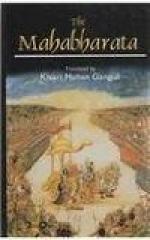350. Of equal name, because the word go means cow, earth, and speech.
351. No particular number is intended. What is meant is—innumerable.
352. The ‘hence’ in the last line has reference to what has been said before on the subject of kine, and not to the first line of the verse.
353. Vitasokaih in the instrumental plural refers to Bhavanaih or some such substantive understood. It may also be react as a nominative plural, referring to Lokah.
354. Very probably what is said here is that only such kine are worthy of being given away unto Brahmanas, and not lean animals.
355. Kine produce food not only by assisting at tillage of the soil, but also by aiding in the performance of sacrifices. The ghee burnt in the sacrificial fire sustains the under-deities, who pour rain and cause crops to grow.
356. That heat is the originating principle of the growth of many things was well understood by the Rishis.
357. The sense seems to be this: in doing all pious acts, one should first take the aid of a preceptor, even if one be well-conversant with the ordinances one has to follow. Without the selection of a preceptor in the first place, there can be no pious act. In the matter, therefore, of making gifts of kine according to the ordinances laid down, one should seek the help of a preceptor as well as in the matter of every other act of piety.
358. When consciousness of body is lost in Yoga or Samadhi, a temporary Moksha or Emancipation succeeds. Men with cleansed minds behold at such times those regions of supreme felicity to which the speaker refers. Such felicity, of course, is the felicity of Brahma itself.
359. Govritti is imitating the cow in the matter of providing for the morrow. Hence, one, who never thinks of the morrow and never stores anything for future use, is meant.
360. Etachcha in 25 implies gift of a cow, and enam refers to a Brahmana. Dwijaya dattwa, etc, in the first line of 26 seems to be an elaboration of Etachcha.
361. Homyaheth prasute implies for a child born in consequence of a Homa. The fact is, ascetics sometimes created children without the intervention of women and by efficacy of the Homa alone. At such times should people make gifts of kine unto such sires. The mention of Vala-samvriddhaye afterwards implies the birth of children in the usual course.
362. Kshirapaih implies calves that are yet unweaned; that is, the cow should be given at such a time when she is still yielding milk; when, in fact, her calf has not learnt to eat or drink anything besides the milk or its dam.
363. The correct reading of the second line is kshanene vipramuchya as in the Bombay text, and not kshemena vipramuchyeran. The latter reading yields almost no sense. The Burdwan translator, who has committed grave blunders throughout the Anusasana, adheres to the incorrect reading, and makes nonsense of the verse.




